Yan Zhao
MuRating: A High Quality Data Selecting Approach to Multilingual Large Language Model Pretraining
Jul 02, 2025Abstract:Data quality is a critical driver of large language model performance, yet existing model-based selection methods focus almost exclusively on English. We introduce MuRating, a scalable framework that transfers high-quality English data-quality signals into a single rater for 17 target languages. MuRating aggregates multiple English "raters" via pairwise comparisons to learn unified document-quality scores,then projects these judgments through translation to train a multilingual evaluator on monolingual, cross-lingual, and parallel text pairs. Applied to web data, MuRating selects balanced subsets of English and multilingual content to pretrain a 1.2 B-parameter LLaMA model. Compared to strong baselines, including QuRater, AskLLM, DCLM and so on, our approach boosts average accuracy on both English benchmarks and multilingual evaluations, with especially large gains on knowledge-intensive tasks. We further analyze translation fidelity, selection biases, and underrepresentation of narrative material, outlining directions for future work.
TacCompress: A Benchmark for Multi-Point Tactile Data Compression in Dexterous Manipulation
May 22, 2025Abstract:Though robotic dexterous manipulation has progressed substantially recently, challenges like in-hand occlusion still necessitate fine-grained tactile perception, leading to the integration of more tactile sensors into robotic hands. Consequently, the increased data volume imposes substantial bandwidth pressure on signal transmission from the hand's controller. However, the acquisition and compression of multi-point tactile signals based on the dexterous hands' physical structures have not been thoroughly explored. In this paper, our contributions are twofold. First, we introduce a Multi-Point Tactile Dataset for Dexterous Hand Grasping (Dex-MPTD). This dataset captures tactile signals from multiple contact sensors across various objects and grasping poses, offering a comprehensive benchmark for advancing dexterous robotic manipulation research. Second, we investigate both lossless and lossy compression on Dex-MPTD by converting tactile data into images and applying six lossless and five lossy image codecs for efficient compression. Experimental results demonstrate that tactile data can be losslessly compressed to as low as 0.0364 bits per sub-sample (bpss), achieving approximately 200$\times$ compression ratio compared to the raw tactile data. Efficient lossy compressors like HM and VTM can achieve about 1000x data reductions while preserving acceptable data fidelity. The exploration of lossy compression also reveals that screen-content-targeted coding tools outperform general-purpose codecs in compressing tactile data.
DualComp: End-to-End Learning of a Unified Dual-Modality Lossless Compressor
May 22, 2025Abstract:Most learning-based lossless compressors are designed for a single modality, requiring separate models for multi-modal data and lacking flexibility. However, different modalities vary significantly in format and statistical properties, making it ineffective to use compressors that lack modality-specific adaptations. While multi-modal large language models (MLLMs) offer a potential solution for modality-unified compression, their excessive complexity hinders practical deployment. To address these challenges, we focus on the two most common modalities, image and text, and propose DualComp, the first unified and lightweight learning-based dual-modality lossless compressor. Built on a lightweight backbone, DualComp incorporates three key structural enhancements to handle modality heterogeneity: modality-unified tokenization, modality-switching contextual learning, and modality-routing mixture-of-experts. A reparameterization training strategy is also used to boost compression performance. DualComp integrates both modality-specific and shared parameters for efficient parameter utilization, enabling near real-time inference (200KB/s) on desktop CPUs. With much fewer parameters, DualComp achieves compression performance on par with the SOTA LLM-based methods for both text and image datasets. Its simplified single-modality variant surpasses the previous best image compressor on the Kodak dataset by about 9% using just 1.2% of the model size.
Finding Counterfactual Evidences for Node Classification
May 16, 2025Abstract:Counterfactual learning is emerging as an important paradigm, rooted in causality, which promises to alleviate common issues of graph neural networks (GNNs), such as fairness and interpretability. However, as in many real-world application domains where conducting randomized controlled trials is impractical, one has to rely on available observational (factual) data to detect counterfactuals. In this paper, we introduce and tackle the problem of searching for counterfactual evidences for the GNN-based node classification task. A counterfactual evidence is a pair of nodes such that, regardless they exhibit great similarity both in the features and in their neighborhood subgraph structures, they are classified differently by the GNN. We develop effective and efficient search algorithms and a novel indexing solution that leverages both node features and structural information to identify counterfactual evidences, and generalizes beyond any specific GNN. Through various downstream applications, we demonstrate the potential of counterfactual evidences to enhance fairness and accuracy of GNNs.
Progressive Inertial Poser: Progressive Real-Time Kinematic Chain Estimation for 3D Full-Body Pose from Three IMU Sensors
May 08, 2025Abstract:The motion capture system that supports full-body virtual representation is of key significance for virtual reality. Compared to vision-based systems, full-body pose estimation from sparse tracking signals is not limited by environmental conditions or recording range. However, previous works either face the challenge of wearing additional sensors on the pelvis and lower-body or rely on external visual sensors to obtain global positions of key joints. To improve the practicality of the technology for virtual reality applications, we estimate full-body poses using only inertial data obtained from three Inertial Measurement Unit (IMU) sensors worn on the head and wrists, thereby reducing the complexity of the hardware system. In this work, we propose a method called Progressive Inertial Poser (ProgIP) for human pose estimation, which combines neural network estimation with a human dynamics model, considers the hierarchical structure of the kinematic chain, and employs a multi-stage progressive network estimation with increased depth to reconstruct full-body motion in real time. The encoder combines Transformer Encoder and bidirectional LSTM (TE-biLSTM) to flexibly capture the temporal dependencies of the inertial sequence, while the decoder based on multi-layer perceptrons (MLPs) transforms high-dimensional features and accurately projects them onto Skinned Multi-Person Linear (SMPL) model parameters. Quantitative and qualitative experimental results on multiple public datasets show that our method outperforms state-of-the-art methods with the same inputs, and is comparable to recent works using six IMU sensors.
DATA-WA: Demand-based Adaptive Task Assignment with Dynamic Worker Availability Windows
Mar 27, 2025Abstract:With the rapid advancement of mobile networks and the widespread use of mobile devices, spatial crowdsourcing, which involves assigning location-based tasks to mobile workers, has gained significant attention. However, most existing research focuses on task assignment at the current moment, overlooking the fluctuating demand and supply between tasks and workers over time. To address this issue, we introduce an adaptive task assignment problem, which aims to maximize the number of assigned tasks by dynamically adjusting task assignments in response to changing demand and supply. We develop a spatial crowdsourcing framework, namely demand-based adaptive task assignment with dynamic worker availability windows, which consists of two components including task demand prediction and task assignment. In the first component, we construct a graph adjacency matrix representing the demand dependency relationships in different regions and employ a multivariate time series learning approach to predict future task demands. In the task assignment component, we adjust tasks to workers based on these predictions, worker availability windows, and the current task assignments, where each worker has an availability window that indicates the time periods they are available for task assignments. To reduce the search space of task assignments and be efficient, we propose a worker dependency separation approach based on graph partition and a task value function with reinforcement learning. Experiments on real data demonstrate that our proposals are both effective and efficient.
Preventing the Popular Item Embedding Based Attack in Federated Recommendations
Feb 18, 2025



Abstract:Privacy concerns have led to the rise of federated recommender systems (FRS), which can create personalized models across distributed clients. However, FRS is vulnerable to poisoning attacks, where malicious users manipulate gradients to promote their target items intentionally. Existing attacks against FRS have limitations, as they depend on specific models and prior knowledge, restricting their real-world applicability. In our exploration of practical FRS vulnerabilities, we devise a model-agnostic and prior-knowledge-free attack, named PIECK (Popular Item Embedding based Attack). The core module of PIECK is popular item mining, which leverages embedding changes during FRS training to effectively identify the popular items. Built upon the core module, PIECK branches into two diverse solutions: The PIECKIPE solution employs an item popularity enhancement module, which aligns the embeddings of targeted items with the mined popular items to increase item exposure. The PIECKUEA further enhances the robustness of the attack by using a user embedding approximation module, which approximates private user embeddings using mined popular items. Upon identifying PIECK, we evaluate existing federated defense methods and find them ineffective against PIECK, as poisonous gradients inevitably overwhelm the cold target items. We then propose a novel defense method by introducing two regularization terms during user training, which constrain item popularity enhancement and user embedding approximation while preserving FRS performance. We evaluate PIECK and its defense across two base models, three real datasets, four top-tier attacks, and six general defense methods, affirming the efficacy of both PIECK and its defense.
L3TC: Leveraging RWKV for Learned Lossless Low-Complexity Text Compression
Dec 24, 2024
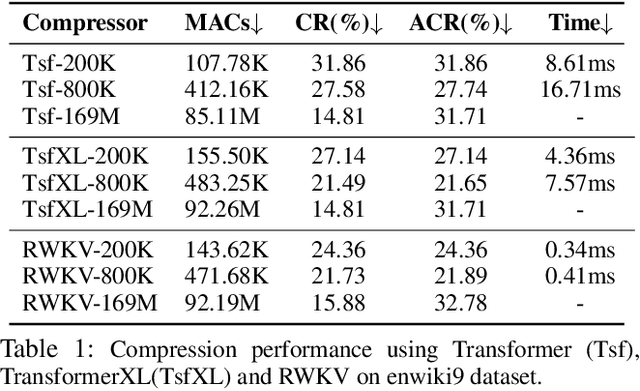


Abstract:Learning-based probabilistic models can be combined with an entropy coder for data compression. However, due to the high complexity of learning-based models, their practical application as text compressors has been largely overlooked. To address this issue, our work focuses on a low-complexity design while maintaining compression performance. We introduce a novel Learned Lossless Low-complexity Text Compression method (L3TC). Specifically, we conduct extensive experiments demonstrating that RWKV models achieve the fastest decoding speed with a moderate compression ratio, making it the most suitable backbone for our method. Second, we propose an outlier-aware tokenizer that uses a limited vocabulary to cover frequent tokens while allowing outliers to bypass the prediction and encoding. Third, we propose a novel high-rank reparameterization strategy that enhances the learning capability during training without increasing complexity during inference. Experimental results validate that our method achieves 48% bit saving compared to gzip compressor. Besides, L3TC offers compression performance comparable to other learned compressors, with a 50x reduction in model parameters. More importantly, L3TC is the fastest among all learned compressors, providing real-time decoding speeds up to megabytes per second. Our code is available at https://github.com/alipay/L3TC-leveraging-rwkv-for-learned-lossless-low-complexity-text-compression.git.
MILLION: A General Multi-Objective Framework with Controllable Risk for Portfolio Management
Dec 04, 2024



Abstract:Portfolio management is an important yet challenging task in AI for FinTech, which aims to allocate investors' budgets among different assets to balance the risk and return of an investment. In this study, we propose a general Multi-objectIve framework with controLLable rIsk for pOrtfolio maNagement (MILLION), which consists of two main phases, i.e., return-related maximization and risk control. Specifically, in the return-related maximization phase, we introduce two auxiliary objectives, i.e., return rate prediction, and return rate ranking, combined with portfolio optimization to remit the overfitting problem and improve the generalization of the trained model to future markets. Subsequently, in the risk control phase, we propose two methods, i.e., portfolio interpolation and portfolio improvement, to achieve fine-grained risk control and fast risk adaption to a user-specified risk level. For the portfolio interpolation method, we theoretically prove that the risk can be perfectly controlled if the to-be-set risk level is in a proper interval. In addition, we also show that the return rate of the adjusted portfolio after portfolio interpolation is no less than that of the min-variance optimization, as long as the model in the reward maximization phase is effective. Furthermore, the portfolio improvement method can achieve greater return rates while keeping the same risk level compared to portfolio interpolation. Extensive experiments are conducted on three real-world datasets. The results demonstrate the effectiveness and efficiency of the proposed framework.
Efficient Data-aware Distance Comparison Operations for High-Dimensional Approximate Nearest Neighbor Search
Nov 26, 2024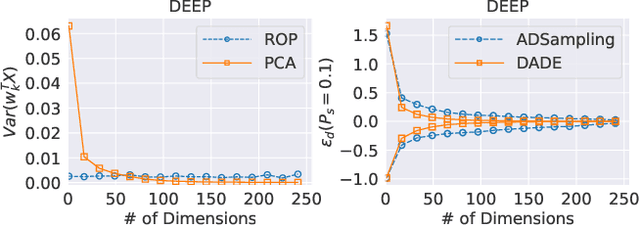
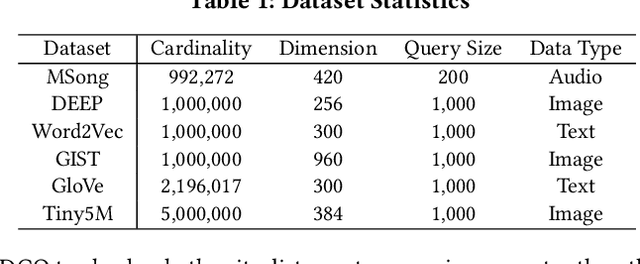
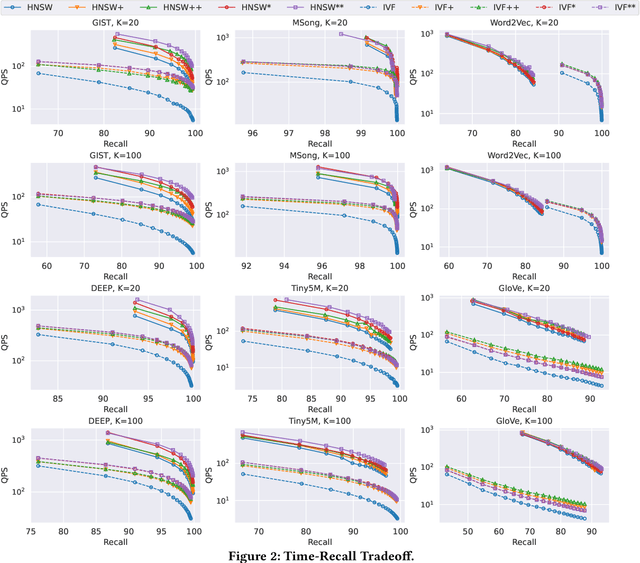
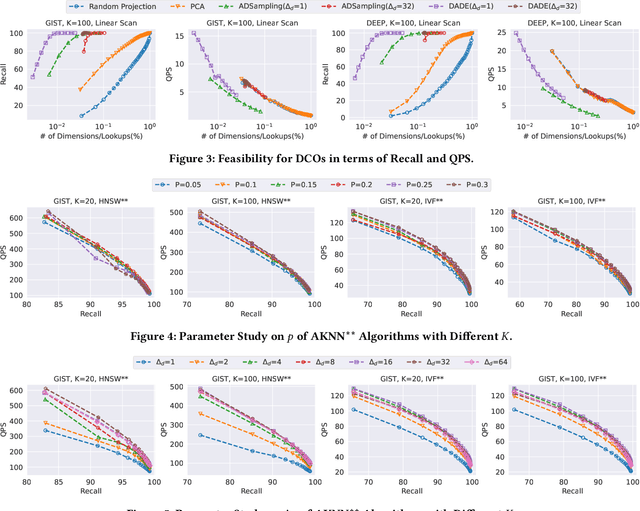
Abstract:High-dimensional approximate $K$ nearest neighbor search (AKNN) is a fundamental task for various applications, including information retrieval. Most existing algorithms for AKNN can be decomposed into two main components, i.e., candidate generation and distance comparison operations (DCOs). While different methods have unique ways of generating candidates, they all share the same DCO process. In this study, we focus on accelerating the process of DCOs that dominates the time cost in most existing AKNN algorithms. To achieve this, we propose an \underline{D}ata-\underline{A}ware \underline{D}istance \underline{E}stimation approach, called \emph{DADE}, which approximates the \emph{exact} distance in a lower-dimensional space. We theoretically prove that the distance estimation in \emph{DADE} is \emph{unbiased} in terms of data distribution. Furthermore, we propose an optimized estimation based on the unbiased distance estimation formulation. In addition, we propose a hypothesis testing approach to adaptively determine the number of dimensions needed to estimate the \emph{exact} distance with sufficient confidence. We integrate \emph{DADE} into widely-used AKNN search algorithms, e.g., \emph{IVF} and \emph{HNSW}, and conduct extensive experiments to demonstrate the superiority.
 Add to Chrome
Add to Chrome Add to Firefox
Add to Firefox Add to Edge
Add to Edge